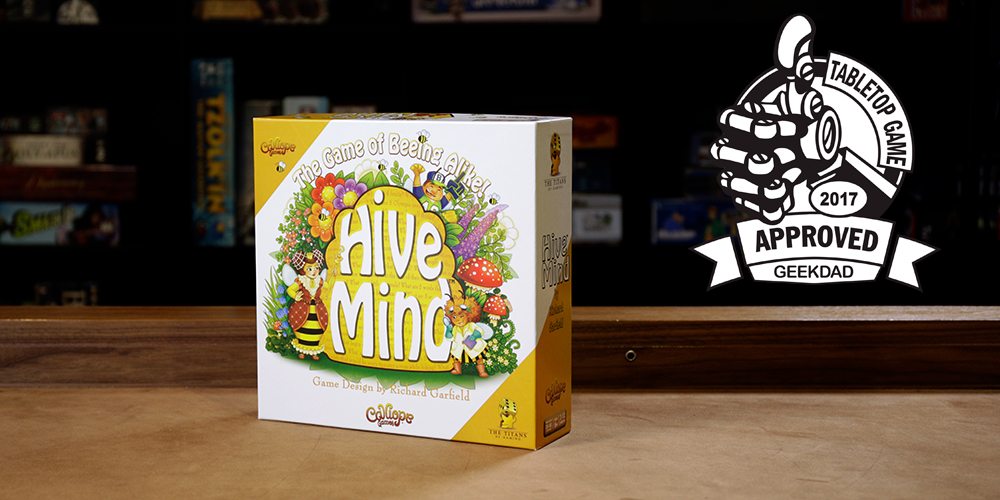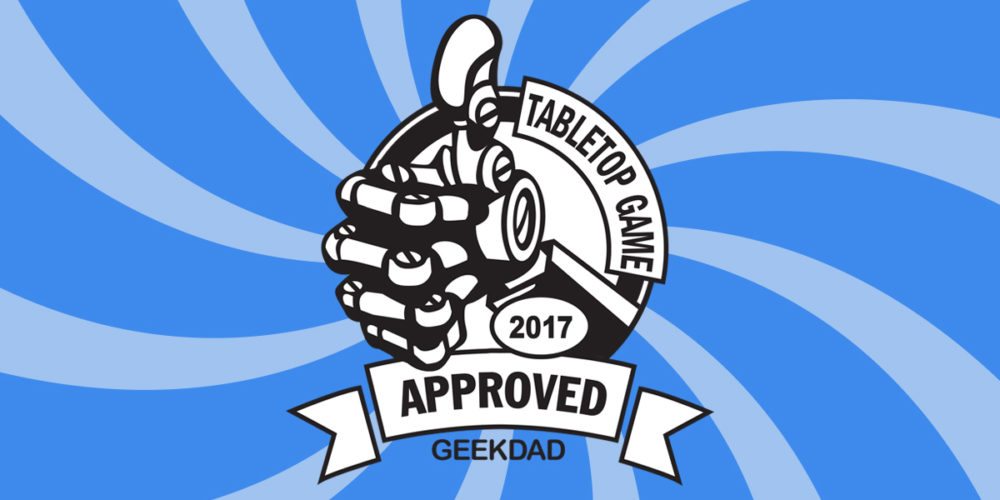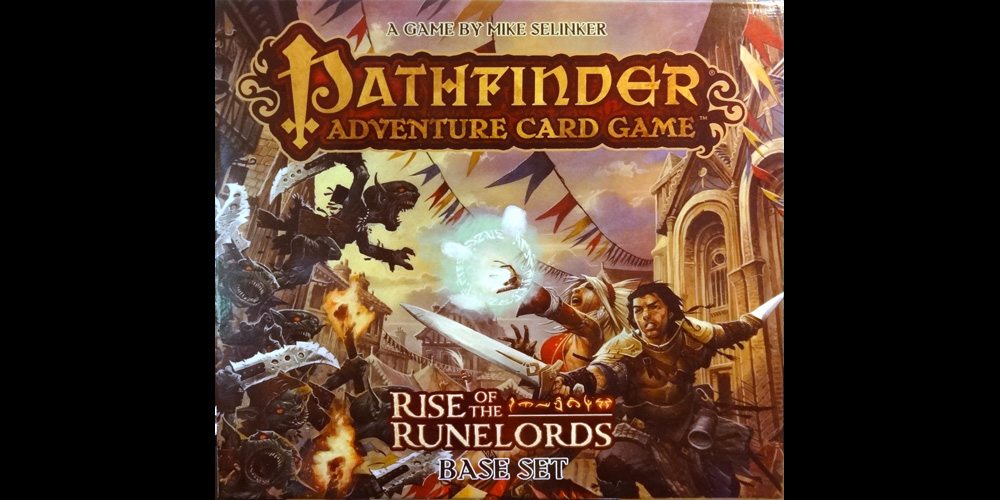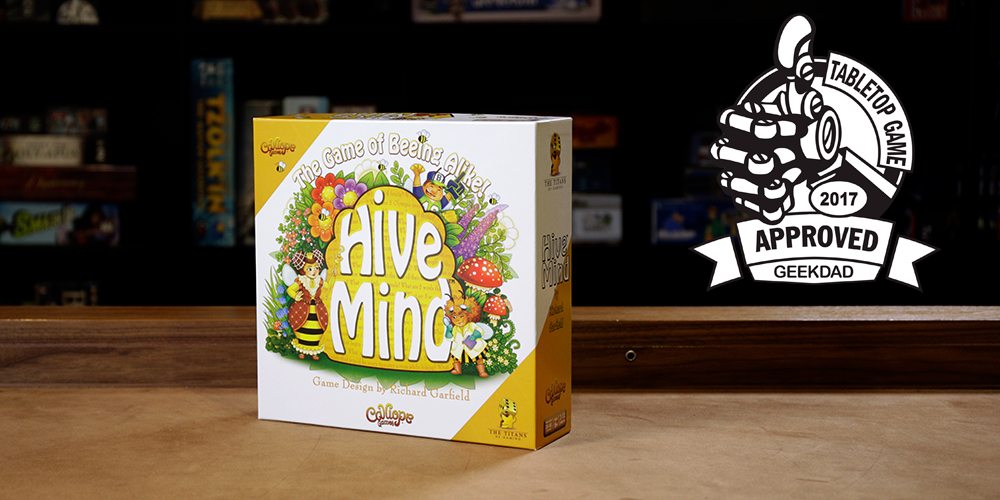
This “being different and unique” is for the birds. Thinking like everyone else and fitting in is where it’s at … in Hive Mind, at least. In this family-friendly party game, the players who can come up with the most common answers to questions will be the winners. It’s a “Game of Beeing Alike”!
What Is ‘Hive Mind’?
A very fun party game where the goal is to think like everyone else. For 3-12 players, Hive Mind is for players 8 and up and plays in 30-90 minutes, depending on how seriously you’re paying attention to the game, rather than just having a good time.
What’s in the Box?
Hive Mind doesn’t take a lot to play, but the pieces are important. In the box, you’ll find:
- 1 Game board
- 300 Double-sided Question cards
- 1 Notepad
- 12 Pencils
- 3 Hive Gates
- 1 Six-sided die
- 1 Two-minute timer
- 1 Queen Bee token
- 12 Bee pawns (BEEPLES!!)
That’s it. You’ll run through the paper fairly quickly is you play this game a lot or with a lot of people. And the pencils may get replaced with pens, whose tips won’t break, but each is branded with the Hive Mind logo and art and it’s expected that they be included in a game like this.

The board is a small size, 9″ x 18″ when opened and has lovely and colorful hive related artwork. There are lots of flowers and garden elements and a very fancifully imagined bee hive, complete with a library, a gym, school, movie theater, cafeteria, and more. (Hey, bees are busy!)
The double-sided Question cards have three questions on each side, meaning there are 1,800 question in the game. Questions range from “What are 3 long running TV shows?” to “What are 5 things that come to mind when you think of morning?”.
The player pawns, shaped like bees and hilariously called Beeples in the rulebook, come in a dozen different colors, though some are pretty close to each other, think light green and dark green. They have a tendency to fall over, but it doesn’t matter. Every time I say “Beeple,” I giggle a little. The Queen Bee gets a decal showing her highness in all her regal glory.
The hive gates are just wood blanks that go on the board as a catch-up mechanism. The two-minute timer averaged 1:57 over four turns of the timer. (I was bored.) There is also a Hive Mind app that will count down exactly 120 seconds and (bonus!) play Flight of the Bumblebee. Don’t worry, you can turn the music off. The die is a bumblebee-themed yellow with black pips.
The bee theme is evident throughout the components and even the box for the Question cards and the insert. It’s all rather beee-autiful.
Hive Mind is GeekDad Approved!
How Do You Play ‘Hive Mind’?
To setup, each player gets a sheet of paper and something to write with. A bee covered pencil is a good bet. The Queen Bee goes on here starting position, outside the hive, among the flowers on the spot marked “Queen Bee Start”. Players choose their beeple and place it at the top of the hive. There are six levels of the hive, but if you’re playing with 8 or more, the top two levels are considered a single level — because it’s crowded at the top. Next, place the Hive Gates. If playing with 7 or less, place at the bottom of levels 4, 5, and 6. If you’re playing with 8 or more, don’t place a gate at the exit of 4.
Let’s get busy!

Decide on a first player. This person rolls the die and moves the Queen Bee. Where the Queen stops dictates how the Beeples will move when the round is scored. If, for instance, the Queen lands on a flower with a single bee, this signifies that the single lowest score will be pushed down a level, toward the exit of the hive, at the end of the round. Most of the Queen’s movement at the beginning of the game will be pushing a single low score. More on scoring and movement in a moment.
The active player then draw a Question card and selects a question from it. There are six choices, but the active player can always choose to create and ask their own question. The question might be something like “What are 3 square things?”. Players then silently and covertly write down their answers to the current question. It’s not mandatory that you use the time, but it helps to hurry people along. The two minutes goes quickly and it’s OK to cut people short. Some people simply do not belong (in the hive).
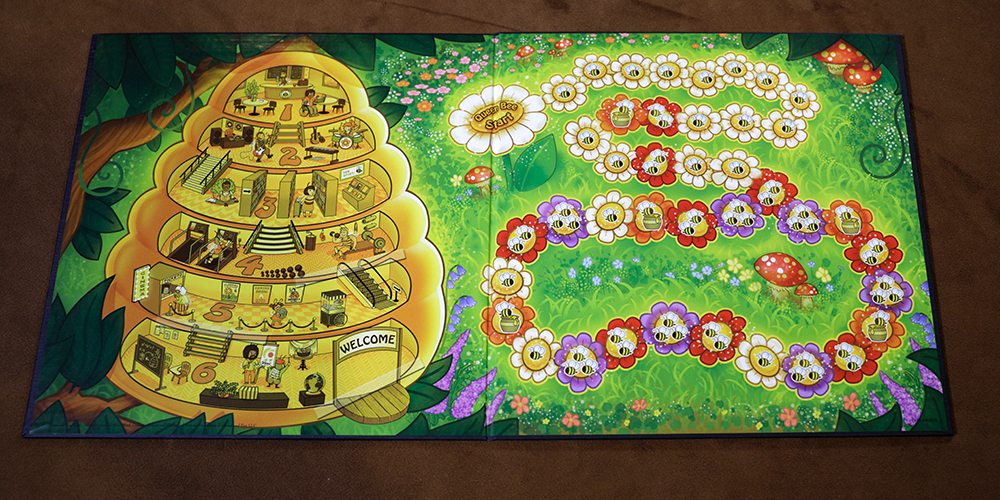
Next, players take turns reading their responses, beginning with the active player. You get a point for your answer and then another point for each other person that wrote down the same answer. Go all the way around the table until all players have responded and mentioned all of their answers. It doesn’t matter if the answer is correct, either. If someone said zebras were one of their 3 square things, he gets a point. And another for each additional player who mentioned zebras.
Finally, players tally points and the lowest get pushed toward the exit of the hive. Depending on where the Queen landed after rolling the die and moving, this may mean the lowest one, two, or three scores. Multiple people can share the same score, so it is possible for everyone to be pushed toward the exit. Gates halt movement down — rather than moving to the next level, the downward moving Beeple removes the gate instead. There is one final movement: the honeypot. When the Queen lands on this spot, the highest scoring player gets to move up one level toward the top. Ties move multiple Beeples. Play continues until one (or more) Beeples are pushed out of the hive on a single round. If you’re still in the hive, you win!

What’s the Buzz on this Game?
Hive Mind is one of the first games from Calliope Games’ Titans Series that brings simple, fun, family games to you by tabletop’s best designers. Hive Mind is by some guy named Richard Garfield, who has done a few games you may have heard of — The Great Dalmutti, Twitch, and Pecking Order. (He also did a few others, which you may have heard of: Magic: The Gathering, Android: Netrunner, and King of New York.) Hive Mind is a reimagination of one of Garfield’s earlier games, What Were You Thinking?
Hive Mind is the antithesis of Scattegories. Rather than strain your brain to come up with unique answers that you don’t think anyone else will think of, you have to come up with the ones everyone else will. Sometimes, it’s really maddening when you have that perfect answer and no one else gets it. (A month ago, I was playing with a group of younger people and none of them — NONE! — wrote down cheese or wine as items that reminded them of France. What the heck?)

The game becomes even more enjoyable when playing with people you know well. But it can also lead to some embarrassing, awkward, and sometimes bawdy moments when the active player comes up with their own questions. Please be mindful of your audience!
Hive Mind is one that I have played a lot of since it released late last year. It’s also a game that I have such a good time playing — just laughing and interacting with friends — that it’s a game I never really care if I win or lose. I just love playing.
It’s a game that seems like it would be really easy to come up with common answers, but it proves, time and time again, that what is common to you isn’t common to everyone else. Some questions, which seem like they would be easy, can be hair pulling when your mind goes blank and the timer is quickly emptying out.
Hive Mind is a wonderful game and can be easily adapted to match the spirit of whatever group you’re playing with and every time it hits my table, it’s an absolute winner. There are 1,800 questions in the box and with the quadrillions of others you can come up with, it has limitless replayability. It’s so much fun and, for all these reasons, it’s GeekDad Approved.
Hive Mind is available now. It retails for $30, but can be found at discounted prices. Other games out (so far) in the Titans Series include Running with the Bulls (Paul Peterson), Menu Masters (Zach and Jordan Weisman), and the upcoming Ancestree (Eric M. Lang).
Disclosure: This game was purchased by me.

